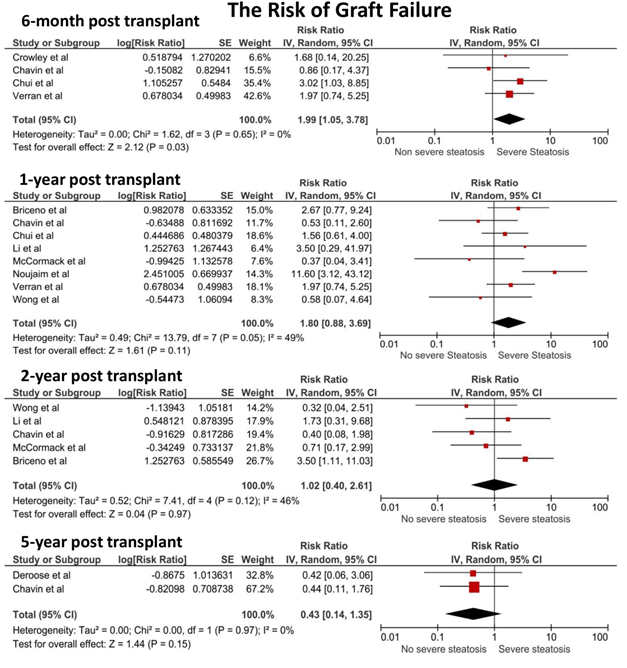Outcomes of Moderately to Severely Steatotic Grafts in Liver Transplantation: A Meta-Analysis.
1Mayo Clinic, Rochester
2Bassett Medical Center, Cooperstown
Meeting: 2017 American Transplant Congress
Abstract number: C202
Keywords: Graft survival, Liver, Liver grafts
Session Information
Session Name: Poster Session C: Organ Allocation, Meld Score, Organ Utilization, and Transplant Outcomes
Session Type: Poster Session
Date: Monday, May 1, 2017
Session Time: 6:00pm-7:00pm
 Presentation Time: 6:00pm-7:00pm
Presentation Time: 6:00pm-7:00pm
Location: Hall D1
Background/Objectives:There is a worldwide need to expand the pool of available liver grafts. Livers with >50% steatosis are discarded for orthotopic liver transplantation (OLT) by most centers, as outcomes using these allografts are controversial. The aim of this study was to assess the risks of graft failure and patient survival in recipients of grafts with >50% steatosis.
Methods:A literature search was performed using MEDLINE, EMBASE, and Cochrane Database of Systematic Reviews from inception through September 2016. Studies that reported relative risks, odd ratios, or hazard ratios comparing the risk of graft failure in patients who received grafts with >50% macrosteatosis versus those who did not receive moderately to severely steatotic grafts were included. Pooled risk ratios (RR) and 95% confidence interval (CI) were calculated using a random-effect, generic inverse variance method.
Results:Thirteen observational studies with 2,035 patients were included in our analysis to assess the association between the use of moderately to severely steatotic graft and graft failure in liver transplantation. The pooled RRs of graft failure and mortality at 6 month in patients who received moderately to severely steatotic graft were 1.99 (95% CI, 1.05-3.78) and 3.07 (95% CI, 1.26-7.46) respectively. However, the risks of graft failure and mortality between these 2 groups were not statistically significant at 1, 2 and 5-year post transplant with RRs of graft failure of 1.80 (0.88-3.69), 1.02 (0.40-2.61) and 0.43 (0.14-1.35), respectively and RRs of mortality of 1.54 (0.78-3.05), 1.17 (0.58-2.35) and 0.94 (0.38-2.29), respectively  .
.
Conclusions:Our study demonstrates statistically significant association between the use of moderately to severely steatotic graft and increased risk of short-term graft failure and patient mortality. However, the use of severely steatotic graft does not increase long-term graft failure or mortality. Our study provides evidence that moderately to severely steatotic grafts should be considered for use in liver transplantation given the growing discrepancy between organ availability and need.
CITATION INFORMATION: Bonner K, Thongprayoon C, Cheungpasitporn W, Leise M. Outcomes of Moderately to Severely Steatotic Grafts in Liver Transplantation: A Meta-Analysis. Am J Transplant. 2017;17 (suppl 3).
To cite this abstract in AMA style:
Bonner K, Thongprayoon C, Cheungpasitporn W, Leise M. Outcomes of Moderately to Severely Steatotic Grafts in Liver Transplantation: A Meta-Analysis. [abstract]. Am J Transplant. 2017; 17 (suppl 3). https://atcmeetingabstracts.com/abstract/outcomes-of-moderately-to-severely-steatotic-grafts-in-liver-transplantation-a-meta-analysis/. Accessed December 13, 2025.« Back to 2017 American Transplant Congress
